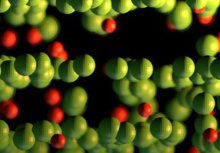Niobium: texture, microstructure, metallurgy
Scripta Materialia 53 (2005) 207-212
EBSD study of grain subdivision of a Goss grain in coarse-grained cold-rolled niobium
Scripta Materialia 53 (2005) 207 rolling[...]
PDF-Dokument [368.1 KB]
The microstructure of as-cast high-purity niobium ingots processed by electron beam melting mostly consists of a few large columnar grains of cm-size. The ensuing plastic deformation of such
coarse-grained materials usually leads to a very inhomogeneous deformation microstructure. Both the gradual grain subdivision during deformation and corresponding nucleation effects
observed during further heat treatment of such coarse-grained refractory metals like niobium, tantalum, and molybdenum were reported earlier to depend
strongly on the initial crystallographic orientation of such large grains. Similar observations that document the orientation dependence of deformation induced
grain subdivision (and, in part, of the subsequent recrystallization) were also reported for iron. In many cases, the substructure was observed to vary from one
grain to another, particular with respect to the overall orientation gradient building up gradually during straining within the original grain borders. It is obvious that a good
understanding of the relationship between grain
orientation and grain fragmentation behavior is a prerequisite to understanding deformation heterogeneity in coarse-grained metals. High-resolution electron backscatter
diffraction (EBSD) in conjunction with a field emission gun scanning electron microscope (FEG-SEM) is a useful analytical tool in that context in that it allows one to study in-grain
orientation gradient effects at the mesoscopic
scale down to a lateral resolution of about 20 nm at an improved angular resolution. Furthermore, the FEG-SEM/EBSD method allows one to study orien-
tation gradients over large areas more easily than in the transmission electron microscope. This latter aspect is of particular relevance when it comes to the investigation of in-grain
texture changes in large crystals. On the other hand, the FEG-SEM/EBSD method is not well suited to distinguish in high detail blurred orientation changes below 1–2° which extend over
a smeared out subgrain wall.
The present paper presents experimental results on deformation-induced grain subdivision in three neighboring coarse grains in a 80% cold-rolled niobium specimen using the FEG-SEM/EBSD
technique. The results reveal noticeable differences in terms of grain fragmentation and microstructural development. Of particular interest is the fragmentation of a large
Goss-oriented grain, which can be described in terms of symmetric orientation changes about the transverse crystal direction.
More specific, deformation-driven grain subdivision of three neighboring grains is investigated in 80% cold-rolled coarse-grained niobium using high-resolution electron backscatter diffraction.
Particular focus is placed on the study of the deformation-induced grain fragmentation of a Goss-oriented crystal.
Scripta Metall 1992 Cu Nb rolling textur[...]
PDF-Dokument [499.4 KB]


